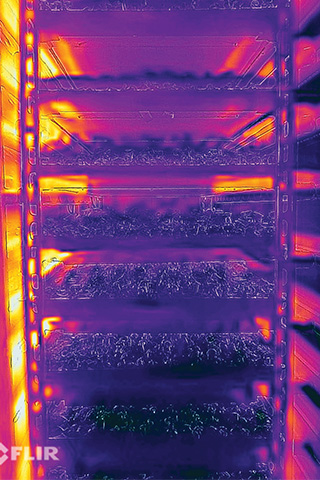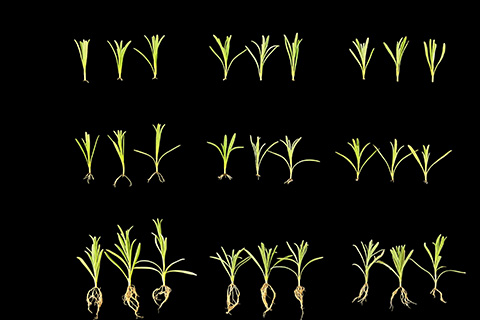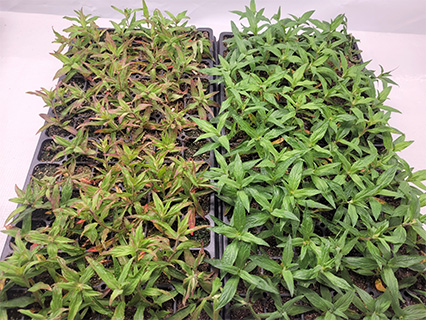5/30/2025
Getting a Leg Up
Celina Gómez, Sungeun Lim & Khadija Mbacke

Indoor farming operations with full environmental control have gained significant momentum over the past decade. Much of the industry has focused on producing quick-turning crops like salad greens and herbs, although some operations are used to grow high-value medicinal plants. Facility designs vary widely—from multi-layer systems with light-emitting diode (LED) fixtures to single-layer setups using high-pressure sodium lamps.
Thermal image illustrating temperature uniformity of a crop inside an indoor propagation facility at Costa Farms in Virginia.
Picture courtesy of Paul R. Fisher.
Indoor growing provides numerous plant-production advantages, including the ability to grow uniform crops year-round, independent of the weather; more efficient use of resources such as space, time and water; and the opportunity to fine-tune plant-quality traits through precise environmental control.
Suitable crops for indoor farming operations must share certain characteristics to ensure economic viability. Unless products are high value with an existing market that’s willing to pay premium prices, they must have a short production cycle, compact growth with a high harvest index, consistent year-round demand and, ideally, low input requirements (think of light, fertilizer and labor). This explains why in the U.S. most attempts at establishing a commercial indoor farming industry have focused on producing salad greens.
However, young plants—which include transplants primarily started from seed, cuttings or tissue culture—share several of the characteristics described above. Some growers in the U.S., known to be early adopters of technology, have shown the advantages of using indoor farming technologies to start young plants indoors for greenhouse finishing. This enables better control of the microclimate and a higher planting density per square foot compared to greenhouse propagation (Figure 1).
For cuttings and tissue-cultured plants, benefits of starting indoors include shrinkage reduction, faster rooting and improved liner quality—advantages that are especially important during the peak propagation season from late winter to early spring. For ornamental seedlings, propagation under LEDs can improve plant growth and uniformity, and may help regulate flowering during finishing stages.
The right environment
Although starting young plants indoors under LEDs is promising, there are unresolved questions about optimum environmental conditions to optimize operation of these capital-intensive systems. For example, the use of controlled environments promises to help growers achieve optimal growth and quality of young plants. However, when dealing with plants started from cuttings, there are limitations to environmental optimization that must be considered.
 While increasing light intensity can help increase root growth, it can also stress cuttings that lack roots to supply water to shoots. This also applies to other environmental conditions that are often recommended to stimulate rooting. Therefore, understanding how to balance environmental effects to maintain turgidity while encouraging root growth—without causing stress— is critical to optimize cutting propagation indoors.
While increasing light intensity can help increase root growth, it can also stress cuttings that lack roots to supply water to shoots. This also applies to other environmental conditions that are often recommended to stimulate rooting. Therefore, understanding how to balance environmental effects to maintain turgidity while encouraging root growth—without causing stress— is critical to optimize cutting propagation indoors.
Effect of light quality and growing environment on rooting of Phenomenal Lavandula ×intermedia cuttings propagated over time.
Due to the large availability of LEDs for sole-source lighting, key questions about starting cuttings indoors tend to first center on what color(s) and how much light to use. Although broadband white LEDs will most likely work for most crops, other wavebands can induce certain plant responses that may be desirable in the early stages of propagation.
For example, our preliminary findings show that far-red and monochromatic blue light have potential to induce early rooting of cuttings, likely due to hormonal effects on adventitious root formation (Figure 2). However, based on myriad LED studies conducted over the past 15 years, we know that light-quality responses can be species-specific, so more studies are needed to define these results with a wide range of species.
Also note that even if these specific wavebands may provide rooting advantages, they may also induce undesirable side effects, such as excessive stem elongation. Therefore, our ongoing work is evaluating the timing of light exposure to optimize rooting benefits while minimizing undesirable stretching. This will also help us understand how quickly cuttings can be transferred to a greenhouse to increase turnover of indoor propagation spaces.
 Another waveband that has potential to affect cutting propagation indoors is blue light. While we know that higher percentages of blue can help keep plants compact, there’s also evidence that it triggers water-relations responses that may affect how much water needs to be given to cuttings to maintain turgidity. This will, of course, affect water-delivery approaches (e.g., misting or fog) when starting cuttings under LEDs.
Another waveband that has potential to affect cutting propagation indoors is blue light. While we know that higher percentages of blue can help keep plants compact, there’s also evidence that it triggers water-relations responses that may affect how much water needs to be given to cuttings to maintain turgidity. This will, of course, affect water-delivery approaches (e.g., misting or fog) when starting cuttings under LEDs.
Cuttings of Firecracker Cuphea started indoors under 140 (left) or 70 μmol∙m-2∙s-1 (right) provided by broadband white LEDs.
Light quality can also help mitigate certain physiological disorders associated with controlled environment production. Intumescence is one of those disorders that’s not often discussed, likely because it’s very species-specific. It appears to be caused by a lack of ultraviolet radiation, which isn’t typically provided by commercial LEDs. Intumescence often causes tumor-like lesions that greatly affect the aesthetic quality of ornamental plants and sometimes reduces growth through limitations in photosynthesis.
Additional findings
In susceptible crops—such as ornamental sweet potato, cuphea and thunbergia—we’ve measured reductions in intumescence by providing far-red radiation to cuttings. However, we have yet to identify a treatment that will completely suppress the disorder. We’ve found that intumescence can also be affected by light intensity, which is very easy to over-apply to cuttings started under LEDs (Figure 3).
Considering results from various studies, we recommend starting cuttings under light intensities that range from 70 to 100 μmol∙m-2∙s-1. Based on our results, lower light intensities may lead to undesirable stretching, and although in some crops we’ve measured rooting benefits with intensities of up to 250 μmol∙m-2∙s-1, growth responses during finishing phases suggest there are only minor benefits from the added energy costs. For most growers, the goal should be to determine the minimum effective light intensity that supports early, uniform, normal root development.
In summary, there are numerous opportunities to start young plants indoors under LEDs, primarily for crops that are slow to root in a greenhouse or that have poor rooting percentages. Fine-tuning light quality and intensity will be critical to optimize operation of these systems. However, industry recommendations will ultimately depend on how these variables interact with other environmental factors, such as temperature, carbon dioxide concentration and vapor-pressure deficit. Our research continues to explore these interactions, aiming to identify rate-limiting steps during the different stages of cutting propagation, which will help us provide practical guidance for improving propagation under LEDs. GT
Celina Gómez is an associate professor and Sungeun Lim is a Ph.D. student. They both work in the Department of Horticulture and Landscape Architecture at Purdue University. Celina can be reached at cgomezva@purdue.edu.